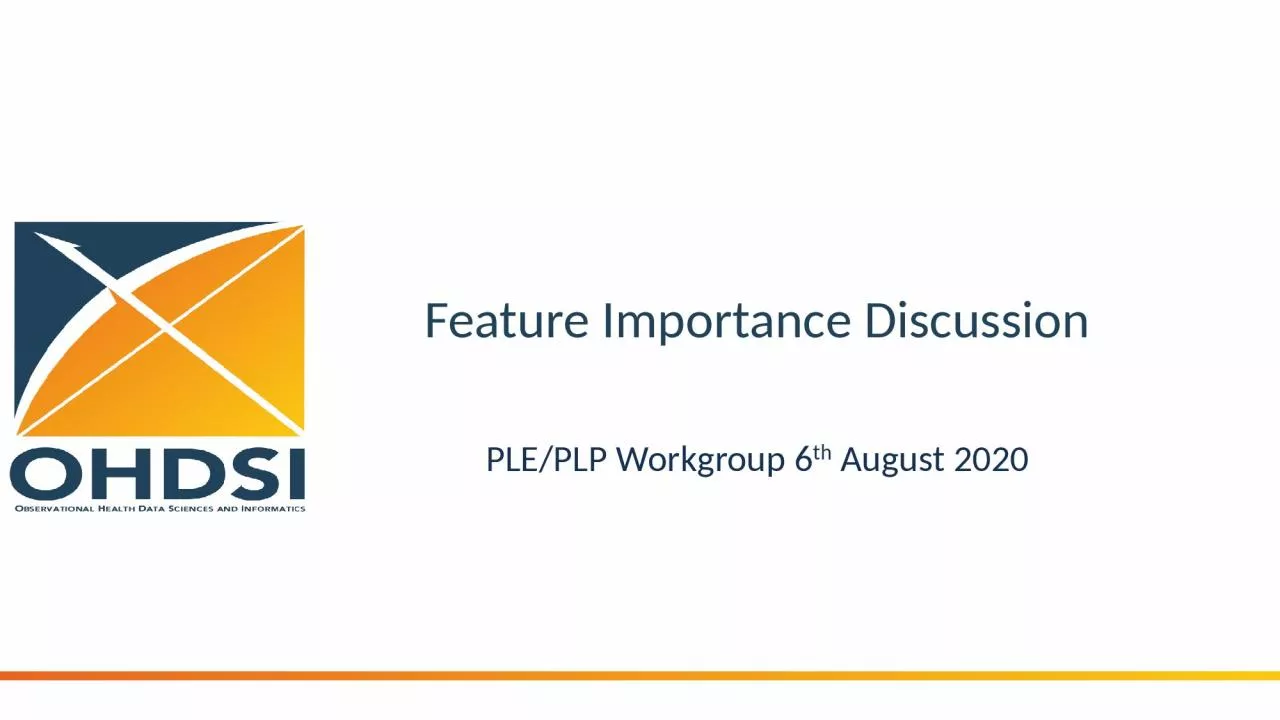

PLEPLP Workgroup 6 th August 2020 Introductions Any new members Summary of Current PLP Feature Importance PLP currently uses variable importance in scikitlearn or coefficients this is not great and may use different methods ID: 1026936
Download Presentation The PPT/PDF document "Feature Importance Discussion" is the property of its rightful owner. Permission is granted to download and print the materials on this web site for personal, non-commercial use only, and to display it on your personal computer provided you do not modify the materials and that you retain all copyright notices contained in the materials. By downloading content from our website, you accept the terms of this agreement.
1. Feature Importance DiscussionPLE/PLP Workgroup 6th August 2020
2. IntroductionsAny new members?
3. Summary of Current PLP Feature ImportancePLP currently uses variable importance in scikit-learn or coefficients – this is not great and may use different methodsClassifierVariable importanceRandom Forest/AdaBoost/Decision TreeGini Importance – for a predictor, for each split involving the predictor sum improvement that the split makes weighted by how many data-points are in the split. Improvement is variable’s impurity measure before split minus weighted impurity measure after split.Gradient Boosting MachinesGain –the relative contribution of the corresponding feature to the model calculated by taking each feature's contribution for each tree in the model. A higher value of this metric when compared to another feature implies it is more important for generating a prediction.LASSO logistic regressionCoefficients – the weight assigned to the variable in the model (requires variables to have an equal scale)KNNNoneDeep LearningNone
4. Current Feature Importance Not Based on ModelWe also use basic measure of association between predictor and outcome: standardized mean difference This does not depend on a specific model
5. Common Feature ImportancePotential other methods commonly used:Permutation feature importance (based on the decrease in model performance)SHAP (based on magnitude of feature attributions)This are both based on the trained model rather than the data
6. Permutation feature importance (PFI)First, a model is fit on the dataset, such as a model that does not support native feature importance scores. Then the model is used to make predictions on a dataset, although the values of a feature (column) in the dataset are scrambled. This is repeated for each feature in the dataset. Then this whole process is repeated 3, 5, 10 or more times. The result is a mean importance score for each input feature (and distribution of scores given the repeats).This approach can be used for regression or classification and requires that a performance metric be chosen as the basis of the importance score, such as the mean squared error for regression and accuracy for classification.
7. IllustrationFeature 1Feature 2Feature 3Feature 4Feature 5Outcome100001110010000010000000001011Feature 1Feature 2Feature 3Feature 4Feature 5Outcome000001010010000010100000101011Original dataAUC = 0.70Feature 1 permuted dataAUC = 0.68Feature 1 PFI = 0.70-0.68 = 0.02
8. PFI Example Plot
9. PFI Pros/ConsProsConsFairly Quick – just permute data per predictor then apply model and calculate AUC (or other metric) decreaseModel specific – with our data correlated variables may not be selected due to the other variable being picked – we won’t know importance of theseModel agnostic– can be applied for any classifier (including KNN)May not account for data correlations (we permute variables individually which may not be realistic)Can focus on AUCGlobal importance onlyConfidence intervals possibleSlow if large number of features
10. SHAP (SHapley Additive exPlanations)Based on game theory Looks at the contribution of a model’s feature for each patient (local interpretability) Global importance also possible by averaging across patientsContribution is based on shapley value – this is the total impact of a feature when considering all combinations of other features
11. Example SHAPExample from internet – the nice thing about SHAP is that you get the impact of the feature per patient so we can plot distributions of importance
12. SHAP Pros/ConsProsConsLocal importanceModel specific – with our data correlated variables may not be selected due to the other variable being picked – we won’t know importance of theseModel agnostic– can be applied for any classifier (including KNN)May not account for data correlations (if a variable is missing then imputes which may be unrealistic)Can show positive/negative contributionNot sure how well it scales
13. Other methodsPartial importance (PI) Individual conditional importance (ICI) plots Partial dependence (PD) Individual conditional expectation (ICE) plotsLIME (estimate complex model with simple interpretable model – e.g., linear model)LOCO (like PFI but refits model – too computational)Plus plenty more…
14. Current workI’ve started to add PFI – I’m doing in in parallel to speed things up https://github.com/OHDSI/PatientLevelPrediction/blob/development/R/FeatureImportance.R But before focusing on this…
15. 10 min group discussion1. Should we focus on feature importance – what are the use cases in PLE and PLP?2. Any other useful methods we should consider?3. What method/s should we focus on (if any)
16. 10 min research collaboration ideasShall we do an OHDSI network study into feature importance?What things are important to assess? (speed, interpretability, …)
17. If we have time…Any ideas to improve our clinical application publication chance?